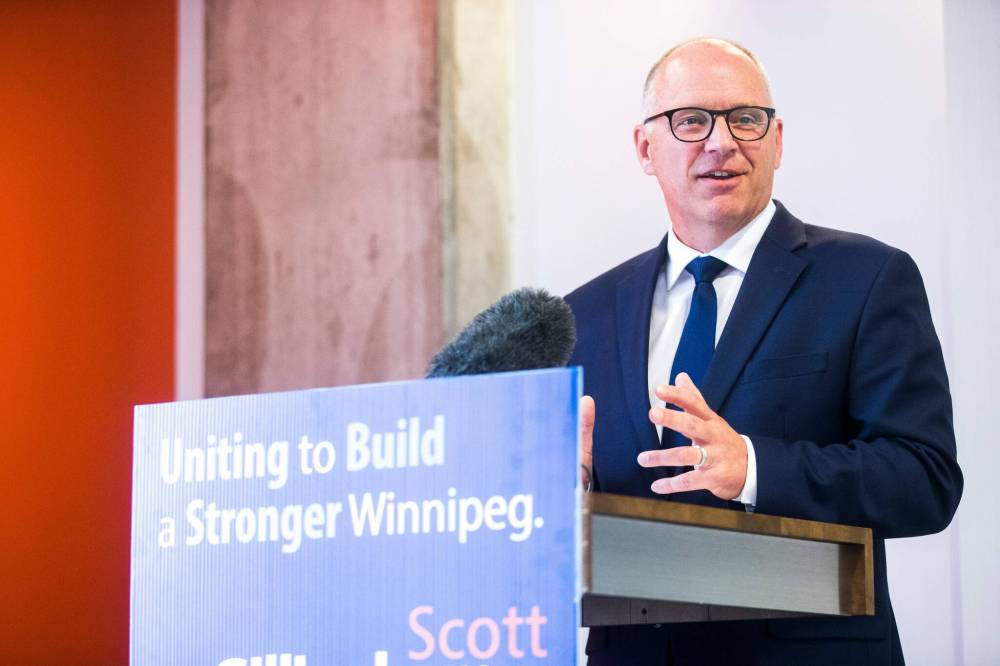Gillingham’s housing plan moving on up
Advertisement
Read this article for free:
or
Already have an account? Log in here »
To continue reading, please subscribe:
Monthly Digital Subscription
$19 $0 for the first 4 weeks*
- Enjoy unlimited reading on winnipegfreepress.com
- Read the E-Edition, our digital replica newspaper
- Access News Break, our award-winning app
- Play interactive puzzles
*No charge for 4 weeks then billed as $19 every four weeks (new subscribers and qualified returning subscribers only). Cancel anytime.
Read unlimited articles for free today:
or
Already have an account? Log in here »
Hey there, time traveller!
This article was published 26/07/2022 (786 days ago), so information in it may no longer be current.
The city is missing out on “low-hanging fruit” by not pushing for more housing atop commercial buildings, says Winnipeg mayoral candidate Scott Gillingham.
At the corner of Portage Avenue and Basswood Place Wednesday, Gillingham, the St. James councillor since 2014, pointed to a convenience store with a near-empty parking lot as an example of an ideal site for apartment construction.
“I envision a future where there is not a single-storey building or empty parking lot along Portage Avenue or Pembina Highway,” he said.

MIKAELA MACKENZIE / WINNIPEG FREE PRESS FILES
Mayoral candidate Scott Gillingham would like to see more housing build on top of commercial buildings.New infill housing guidelines were passed last year, including rules on where infill housing could be built and how tall they could be, for the city’s more established neighbourhoods. Gillingham said there’s opportunity for residential spaces in sites zoned for commercial use.
“(These sites) offer room for literally thousands of new homes with a minimum of political and regulatory conflicts,” he said.
If he’s elected on Oct. 26, he promised to seek council approval for such residential construction with no parking minimums. Areas such as Pembina Highway and Portage Avenue are close to transit and have parking, he said, noting zoning rules allow up to four storeys of commercial construction. He would introduce new mixed-use zoning rules for these areas to allow mid-rise housing to be built as long as a business is maintained in the building.
Retail malls could also have homes built on top of them depending on the effect of nearby residents, he said.
His plan includes financial help for any firm that agrees to build affordable housing units on top of the Portage Place mall, and to hold public hearings on converting office spaces, rendered empty by COVID-19, to residences.
“By building along the corridors of Portage Avenue or Pembina Highway, you make more units of housing available. One of the ways to address affordability is to make sure there’s ample supply of housing on the market,” he said.
Rental vacancy in Winnipeg is on the rise. Canada Mortgage and Housing Corp. data released in February says it is the highest it has been in 25 years, but 2,915 apartment rental units were added in 2021 — the largest annual increase since 1990.
New housing supply has higher-than-average rent, meaning the 20 per cent of renters who are in the lowest-income category can’t afford them.
Robert Crooks, a member of the West Broadway Tenants Committee, said it’s concerning.
“When we talk about affordable, it sounds great for a mayoral candidate or anyone else to get up there and say we need affordable housing, but we really need to talk about rent-geared-to-income housing. Otherwise, it’s just not affordable,” he said.
Gillingham’s promise to offer a common aid package to any bidder planning to build affordable housing on Portage Place is a positive development as long as it’s affordable housing, Crooks said.
“I know that for a lot of people, building density in the city is really important, and I think I would agree with that. But that only works if you’re providing housing that everybody can access. Otherwise, it’s not going to work,” he said.
Other mayoral candidates expressed skepticism about Gillingham’s initiative.
Jenny Motkaluk called it “unrealistic” and “unproductive.”
“His approach sounds an awful lot like central planning, which the Soviets taught us is a bad idea,” Motkaluk said.
“We have a tremendous number of vacant buildings in Winnipeg, and the focus needs to be on encouraging people to take the plywood off the windows of those buildings, and open them back up.”
Fellow candidate Glen Murray called the plan incomplete and said his own housing platform, which he plans to release in the coming weeks, would provide an all-encompassing approach to affordable housing.
“It’s not randomly sort of picking, ‘We’re going to put housing on top of a shopping mall,’ and we have no idea whether people actually want to live on top of a shopping mall, for example,” he said. “It involves a lot more thought than that.”
Candidate Rick Shone has lived in St. James — Gillingham’s ward — for eight years. The few new housing developments in the area is telling, he said.
Shone also criticized the policy shifting plan as not going far enough: Gillingham said he would end parking minimums at new developments, but Shone has promised to remove parking minimums across the city.
“My first question is why now, Scott?” he said.
malak.abas@freepress.mb.ca

Our newsroom depends on a growing audience of readers to power our journalism. If you are not a paid reader, please consider becoming a subscriber.
Our newsroom depends on its audience of readers to power our journalism. Thank you for your support.




